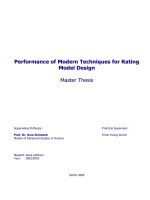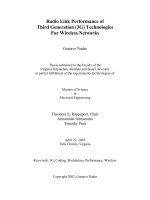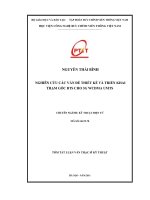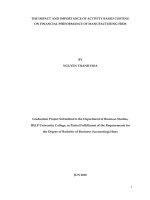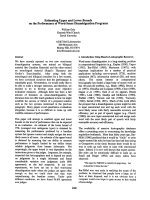broadband data performance of 3g WCDMA
Bạn đang xem bản rút gọn của tài liệu. Xem và tải ngay bản đầy đủ của tài liệu tại đây (414.14 KB, 10 trang )
Performance of 3G
services
There is no single universal measure of per-
formance for a telecommunications system.
Indeed, end-users (subscribers) and system
operators define good performance quite
differently. On the one hand, end-users want
to experience the highest possible level of
quality. On the other hand, operators want
to derive maximum revenue, for example,
by squeezing as many users as possible into
the system.
Until now, performance-enhancing fea-
tures could generally either improve per-
ceived quality of service (QoS) or system per-
formance. But now, with WCDMA Evolved
(Ericsson’s evolution of WCDMA for best-
effort data services), one can potentially do
both.
Mobile best-effort data services, such as
web surfing and file downloads, have been
available via packet data since the first re-
lease of WCDMA networks. They are a sig-
nificant enhancement compared to 2G net-
works, and because the WCDMA specifica-
tions are evolving, packet-data support con-
tinues to improve. The first two phases of
this evolution, commonly referred to as
WCDMA Evolved, entail
• the introduction (in Rel-5) of high-speed
downlink packet access (HSDPA); and
• the introduction (in Rel-6) of an enhanced
uplink.
Compared to earlier releases of WCDMA,
these changes yield better data rates and
shorter delay; that is, they greatly improve
the service experience and system capacity.
End-user perspective
Users of circuit-switched services are as-
sured of a fixed bit rate. The quality of ser-
vice in the context of voice or video tele-
phony services is defined by perceived voice
or video quality. Superior quality services
have fewer bit errors in the received signal.
By contrast, users who download a web page
or movie clip via packet data describe qual-
ity of service in terms of the delay they ex-
perience from the time they start the down-
load until the web page or movie clip is dis-
played.
Best-effort service does not guarantee a
fixed bit rate. Instead, users are allocated
whatever bit rate is available under present
conditions. This is a general property of
Broadband data performance of third-generation
mobile systems
Johan Sköld, Magnus Lundevall, Stefan Parkvall and Magnus Sundelin
The rapid, widespread deployment of WCDMA and an increasing uptake
of third-generation mobile systems (3G) services are bringing network
performance into sharp focus. Besides efficiently supporting an increas-
ing number of subscribers, network systems should also give end-users a
high-speed experience. To solve this equation, with its seemingly conflict-
ing components, we need to understand performance and how it is mea-
sured. Likewise, present-day and evolving 3G systems should include fea-
tures for increasing system performance.
New high-speed services and greater end-user demand for perfor-
mance are driving the evolution. WCDMA Evolved supports an enhanced
broadband experience of WCMDA systems. WCDMA Release 99 (Rel-99)
services have evolved into WCDMA Releases 5 and 6 (Rel-5, Rel-6), which
will reach commercial deployment by year-end 2005. Systems based on
CDMA2000 are going through a similar evolution.
The authors describe the path to WCDMA Evolved and how it affects
performance for end-users and operators.
1xEV-DO CDMA2000 (single-carrier) evolution
with data-only carrier
3GPP Third-generation Partnership Project
16QAM 16-level quadrature amplitude mod-
ulation
ARQ Automatic repeat request
BWA Broadband wireless access
FDD Frequency-division duplex
FTP File transfer protocol
HSDPA High-speed downlink packet access
IEEE Institute of Electrical and Electron-
ics Engineers
MIMO Multiple input/multiple output
antenna system
MWA Mobile wireless access
OFDM Orthogonal frequency-division
multiplexing
QoS Quality of service
Rel-5 Release 5 of 3GPP specifications
Rel-6 Release 6 of 3GPP specifications
Rel-99 Release 99 of 3GPP specifications
(first release)
TCP Transmission control protocol
TDD Time-division duplex
TTI Transmission time interval
UDP User datagram protocol
UMTS Universal mobile telecommunica-
tions system
WCDMA Wideband code-division multiple
access
WiFi Wireless fidelity
WiMAX Worldwide interoperability for
microwave access
BOX A, TERMS AND ABBREVIATIONS
packet-switched networks; that is, network
resources are not reserved for each user.
Given that delay increases with the size of
the object to be downloaded, absolute delay
is not a fair measure of quality of service.
A lone user in a radio network with good
radio conditions may enjoy the peak bit rate
of the air interface. But if radio conditions
are less than optimum or there is interfer-
ence from other users, the air interface bit
rate will be less than the peak bit rate. In
addition, some data packets might be lost,
in which case the missing data must be re-
transmitted further reducing the effective
bit rate as seen from higher protocol layers
(such as IP). What is more, the effective bit
rate diminishes even further as the distance
from the cell increases (due to poorer radio
conditions at cell edges).
The peak air interface rate and radio con-
ditions are not the only factors that limit
performance. Taking the radio network and
core network as a whole all the way to the
application server, one also encounters de-
lays in various network nodes and protocols.
This results in an object bit rate that is lower
than the effective bit rate. The object bit
rate, which is measured at the application
level, takes into account all delays and is av-
eraged over the objects transmitted to or
from an end-user. It is the size of the object
divided by total delay measured in kilobits
per second (kbps).
The transmission control protocol
(TCP)—the protocol at the transport
layer—is commonly used together with IP
traffic. But due to its slow-start algorithm,
which is sensitive to latency in the network,
it is especially prone to cause delay for small
packets. The slow-start algorithm is meant
to ensure that the packet transmission rate
from the source does not exceed the capa-
bility of network nodes and interfaces.
Network latency, which in principle is a
measure of the time it takes for a packet to
travel from a client to server and back again,
has a direct impact on performance with
TCP. Therefore, an important design ob-
jective in WCDMA Evolved has been to re-
duce network latency. One other quality-
Air interface bit rate
Bit rate of the physical layer achieved under
certain radio conditions with specific coding
and modulation.
Peak bit rate
Peak bit rate of the air interface under ideal
radio conditions.
Effective bit rate
Bit rate as seen from higher layers (IP). This
rate is dependent on the bit rate of the air
interface as well as protocol overhead,
retransmissions and queing delays.
Object bit rate
Bit rate defined at the application level, end-
to-end. It includes delays outside the radio
network and delays from TCP flow control.
Latency
End-to-end round-trip time of a small packet.
System throughput
Total number of bits per second transmitted
over the air interface (per sector).
BOX B, DEFINITIONS OF BIT RATES
Figure 1
Definitions of bit rates, end-to-end (see
also Box B).
related criterion affects the setup time for
initiating, for example, a web-browsing ses-
sion.
Operator perspective
Radio resources need to be shared when mul-
tiple users are in the network. As a result,
all data must be queued before it can be
transmitted, which restricts the effective bit
rate to each user. Notwithstanding, by
scheduling radio resources, operators can
improve system throughput or the total
number of bits per second (bps) transmitted
over the air interface. HSDPA and the en-
hanced uplink employ intelligent schedul-
ing methods to optimize performance.
One important performance measure for
operators is the number of active users who
can be connected simultaneously. Given
that system resources are limited, there is a
trade-off, in terms of object bit rate, between
number of active users and perceived qual-
ity of service.
WCDMA Evolved—the next step
To exploit or take full advantage of the
bursty characteristics of packet data and
rapid variations in radio conditions,
WCDMA Evolved applies fast and dynam-
ic resource allocation in both the uplink and
downlink. More specifically, it employs hy-
brid automatic repeat request (ARQ) with
soft-combining, scheduling, and for the
downlink, fast link adaptation with higher-
order modulation (Box C). Corresponding
functionality is contained in the base station
to allow for fast adaptation and low delays.
In addition, the transmission time interval
(TTI) has been reduced to 2ms to accom-
modate faster adaptation and reduce end-
user delay.
Although the principles applied in the
uplink and downlink are similar, certain
fundamental differences have affected de-
sign choices. Most notably, for the down-
link, the shared resource for power and codes
is located in the base station. For the uplink,
the power resource is distributed among the
terminals. Soft handover solely applies to
uplink transmissions.
Performance
achievements
Performance analysis (by means of comput-
er simulations) plays an important role in
Figure 2
In the context of best-effort packet data,
network load (number of users) steers the
bit rate and system throughput on the
downlink. WCDMA Evolved has the
potential to improve bit rate and system
throughput.
Figure 3 (see also Box C)
The evolution path of WCDMA Evolved.
the development of WCDMA Evolved. This
analysis often relies on several assumptions,
which although simplified, give a good in-
dication of network performance, especially
of the relative improvement for HSDPA and
the enhanced uplink compared to WCDMA
Rel-99. Field experience is also invaluable
for obtaining the full picture of achievable
performance.
End-user performance analysis
Below, using Rel-99 as a reference, we will
demonstrate gains in performance from
Rel-5 (HSDPA) and Rel-6 (HSDPA and en-
hanced uplink). The results were derived
under the assumption that radio conditions
do not limit the air interface bit rate. Fur-
ther, it was assumed that the Rel-99 system
provided radio bearer bit rates of 64kbps on
the uplink and 384kbps on the downlink
(denoted 64/384). The corresponding fig-
ures for Rel-5 and Rel-6 are 384/4,320kbps
and 4,320/13,440kbps, respectively. The
bit rates of Rel-5 and Rel-6 are considerably
higher than those of Rel-99, but as we shall
see they are not available over a larger part
of the cell as is often the case for Rel-99.
Performance when transferring large files
using TCP is determined by the bit rate of the
bearer. For small files, latency is important.
To highlight these aspects, the results illus-
trate TCP-based uploads and downloads of
Fast hybrid automatic repeat request ( A R Q )
with soft-combining enables receivers to rapidly
request the retransmission of erroneously
received data blocks. In the downlink, the
receiver is a terminal. In the uplink, the receiver
is the base station. Before decoding a signal,
the receiver combines information from the orig-
inal transmission with that of subsequent trans-
missions. This procedure is called soft-combin-
ing. Fast hybrid ARQ with soft-combining is
used in the uplink and downlink. Compared to
earlier releases of the WCDMA specifications, it
has the potential to substantially reduce delay
and significantly increase capacity.
Fast scheduling is used in the uplink and
downlink. The scheduling strategies for each
may differ, however. Downlink resources
(code and power), for example, are typically
shared in a way that addresses a user with
advantageous instantaneous channel condi-
tions per time interval. Channel-dependent
scheduling, as this strategy is called, exploits
short-term variations in downlink radio condi-
tions to increase capacity. In the uplink, the
transmission power of a mobile terminal is
substantially less than that of the base station.
Therefore, a single user’s transmission cannot
use full system capacity. Multiple users are
thus frequently scheduled in parallel. To con-
trol the overall level of interference in the cell,
the scheduler controls when and at what rate
each terminal should transmit.
Fast link adaptation applies to the down-
link. In essence, downlink transmission power
is held constant while the data rate is rapidly
adjusted to adapt to varying radio conditions.
This method is efficient for services that toler-
ate short-term variations in the data rate.
Channel conditions permitting, spectral-
efficient 16-level quadrature amplitude modu-
lation (16QAM) can be used to further increase
capacity and data rates.
BOX C, BASIC PRINCIPLES OF WCDMA EVOLVED
Figure 4 (see also Box C)
Basic principles of WCDMA Evolved.
• a small, 10KB file (for instance, an e-mail
message without attachment); and
• a large, 5MB file (for example, an MP3
file).
Finally, it was assumed that there is no loss
of IP packets on the fixed network path be-
tween client and server. Packet loss would
affect the results, but this impact has not
been included.
Figure 5 shows upload performance. The
gain from Rel-5 is due to the 384kbps up-
link service. For large file transfers, the ob-
ject bit rate approached the radio bearer bit
rate, and the enhanced uplink in Rel-6 gave
a significant improvement compared to ear-
lier releases. For small file transfers, latency
was a determining factor—one that made it
impossible to reach the radio bearer bit rate.
Rel-6 considerably increased the object bit
rate, primarily by reducing latency.
Figure 6 shows TCP download perfor-
mance. For large file transfers, the intro-
duction of HSDPA (5 codes) increased the
object bit rate by an order of magnitude (10
1
)
compared to Rel-99. Configuring HSDPA
with the maximum of 15 codes further in-
creased the object bit rate to 10Mbps. For
small file transfers, performance was limit-
ed by TCP and network latency. As expect-
ed, Rel-5 improved the object bit rate com-
pared to Rel-99. Especially interesting was
the performance of Rel-6 compared to
Rel-5. The enhanced uplink reduced laten-
cy, which in turn, improved TCP download
performance.
These results demonstrate the capability
of the air interface. However, radio condi-
tions and network load influence the achiev-
able air interface bit rate. Figures 7 and 8
show bit rate availability. The examples de-
pict a single user. Bit rate availability is ex-
pressed in terms of coverage percentage; that
is, the percentage of the cell area where a cer-
tain bit rate can be achieved. The modeled
Rel-6 network has been deployed to provide
an uplink bit rate of at least 64kbps with
95% probability. This means that the net-
work can provide 64kbps in 95% of the cell
area. Due to limited output power in mo-
bile terminals, the uplink generally provides
lower bit rates than the downlink. Heavy
traffic load in the network increases inter-
ference, which reduces coverage. For both
the uplink and downlink, 4Mbps can be
achieved in more than half of the cell area
without load; with load, more than 2Mbps
(Figure 7). These results show the achiev-
able bit rate when a user is allowed to trans-
mit (uplink) or receive (downlink). Multi-
Figure 6
Evolution of WCDMA end-user bit rates for data downloads.
Figure 5
Evolution of WCDMA end-user bit rates for file upload (Note: A logarithmic scale has been
used for the bit rates).
ple users in the cell reduce the effective bit
rate per user because the resources must be
shared by means of scheduling.
System capacity analysis
Until new products become available and
have been deployed in loaded networks,
radio network simulations will be used to
assess system capacity. Simulations are also
used to better control the environment and
conditions for performance analysis. These
simulations include models of the cell lay-
out, traffic behavior, radio propagation, and
assumptions about the receiver performance
of radio base stations and mobile terminals.
Each of these parameters affects the results.
System capacity is defined as average sys-
tem throughput at which perceived quality
drops to an unacceptable level. Greater sys-
tem throughput can be obtained by disre-
garding perceived quality and fairness
among users. This measure of capacity is not
dependent on traffic load generated per user,
which varies from application to applica-
tion.
Figure 8 shows the uplink and downlink
capacity derived from simulations of a macro
cellular network. Capacity intervals are
given to illustrate that these figures are de-
pendent on the models and assumptions
Figure 7
Bit rate availability for WCDMA Evolved.
Figure 8
Heavy traffic load in the network increas-
es interference, which reduces coverage.
used. Compared to Rel-99, the enhanced
uplink yields a 30-90% gain in capacity de-
pending on whether hybrid ARQ has been
optimized for latency (targeting few re-
transmissions) or capacity (targeting multi-
ple retransmissions). In general, in terms of
coverage or stability, maximum uplink ca-
pacity is determined by maximum tolerable
interference.
Thanks to fast scheduling and link adap-
tation, HSDPA gives two to three times
more capacity in the downlink than Rel-99.
The capacity interval (marked in red, Fig-
ure 9) indicates that HSDPA capacity is de-
pendent on the radio environment. Em-
ploying receiver diversity in combination
with interference-suppression techniques in
mobile terminals can further enhance ca-
pacity in the downlink.
The dashed bar (Figure 9) indicates ca-
pacity when more idealized assumptions
have been used: the effect of TCP has been
excluded, and scheduling and cell load have
been optimized to permit as much data as
possible to pass through each cell. This sce-
nario, which is not a favorable choice of op-
erating point for a 3G system, corresponds
to operations at the lower right-hand corner
of Figure 2.
System throughput, expressed in kbps per
cell, is a key parameter for network dimen-
sioning. Using assumptions about sub-
scriber behavior (for example, data volume
generated per month) one can translate sys-
tem throughput into the number of sub-
scribers per cell that the network can sup-
port. Appropriate margins should be ap-
plied to account for variations. Figure 10 de-
scribes the number of subscribers that can
be supported when capacity per sector is
2800kbps.
Field experience
Today, there is a substantial body of field
experience from running large deployments
of Rel-99 WCDMA equipment. WCDMA
Evolved will have its first commercial
launch later this year with HSDPA.
CDMA2000 is moving along a parallel evo-
lution path called 1xEV-DO. The first phase
of CDMA2000 1xEV-DO has already been
deployed commercially.
CDMA2000 1xEV-DO currently sup-
ports peak air interface bit rates of 2.5Mbps.
In a subsequent version, Rev A, it will sup-
port 3.0Mbps. Field trials show that the
high-speed version of CDMA2000 signifi-
cantly increases object bit rates and system
throughput. These improvements have the
Figure 9
System capacity.
Figure 10
Example of capacity of a mobile wireless access service. The capacity calculation (630
subscribers supported by the site) assumes that each subscriber uses 1GB per month, of
which amount 0.6% is during the busy hour. This gives an average data rate of 13.3kbps
per subscriber during the busy hour.
same magnitude and are based on the same
principles as those employed by WCDMA
Evolved.
Figure 11 shows a test of a 500KB FTP
download over
• an EV-DO bearer; and
• a WCDMA Rel-99 bearer.
CDMA2000 has a radio bandwidth of
1.25MHz, whereas WCDMA has a radio
bandwidth of 5MHz. Notwithstanding, we
see that the EV-DO enhancement consider-
ably improves downlink bit rates. Fast link
adaptation adapts quickly to channel con-
ditions, enabling greater object data rates.
It also gives a larger spread of performance
values than WCDMA Rel-99. This is be-
cause channel conditions vary over the test
area. The EV-DO bit rate will thus vary with
conditions. Thanks to its wider bandwidth,
HSDPA will yield even greater downlink
bit rates than 1xEV-DO.
End-user performance might be limited
due to latency when TCP is used as the trans-
port layer protocol for FTP download. EV-
DO is a clear improvement but the latency
(in the specific non-Ericsson 1xEV-DO de-
ployment) limits performance. Ongoing
work to improve latency will enhance the
performance of EV-DO as well as for
WCDMA.
Table 1 shows the potential (from test re-
sults) for further improvement. In addition
to download performance using FTP/TCP,
it shows download performance using the
user datagram protocol (UDP). In this case,
the gains from EV-DO are more obvious:
UDP is not sensitive to latency, so the ob-
ject bit rate for EV-DO is almost doubled.
WCDMA Rel-99 CDMA2000 1xEVDO
FTP/TCP object bit rate 280kbps 320kbps
UDP object bit rate 240kbps 600kbps
Measured latency (ping time to a server) 170ms 300ms
TABLE 1. AVERAGE DOWNLOAD PERFORMANCE FROM A FIELD TEST.
Figure 11
File download performance in a field test.
These results stress the importance of low
latency and indicate the potential of
1xEV-DO and HSDPA. Low latency is re-
quired to exploit the full performance po-
tential of HSDPA and 1xEV-DO. Figure 12
shows the road map for latency and the tar-
gets that will enable improved end-user per-
formance.
Ericsson has developed and built an ex-
perimental WCDMA HSDPA and en-
hanced uplink test bed that closely follows
Rel-6 of the 3GPP specifications. The test
bed, which is based on a commercial
WCDMA Rel-99 network that has been up-
dated with HSDPA and enhanced uplink
functionality, can deliver peak data rates of
more than 10Mbps in the downlink and
1.6Mbps in the uplink. The HSDPA and
enhanced uplink test bed is operating over
the air in Stockholm, Sweden. Its function-
ality and bit rates have been verified in the
field. The user equipment (mobile terminal)
is installed in a car. The RBS, RNC and core
network are part of the Ericsson Experience
Center in Stockholm. The test bed, which
is used for customer demonstrations and
performance measurements, has been in op-
eration (with HSDPA functionality) since
mid-2004.
Complementary
technologies
Several complementary technologies are
candidates for wireless broadband, includ-
ing wireless LAN (WLAN), broadband
wireless access (BWA), and short-range
communications (such as Bluetooth). Each
of these technologies has different proper-
ties in terms of peak bit rate, range, and mo-
bility.
The IEEE 802 standards committee is
working on several technologies. Of these,
IEEE 802.16, driven by the WiMAX
Figure 13
The bandwidth of WCDMA is wider than that of CDMA2000. As a consequence, WCDMA
has a higher peak bit rate. The typical bit rate experienced in the field will thus also be
higher for WCDMA Evolved than for CDMA2000 1xEV-DO.
Figure 12
Latency road map for WCDMA2000.
Forum, is currently the BWA candidate
with the broadest support.
WiMAX
The WiMAX industry forum has made
IEEE 802.16 into an interoperable standard
for broadband wireless access. Previous ver-
sions of the standard were designed for line-
of-sight communication at higher frequen-
cies. The first WiMAX products, based on
published standard 802.16-2004, will be
available in 2005. The 802.16e standard
version (still under development) has
broader support among vendors and will
provide limited mobility. The first prod-
ucts for 802.16e are expected to arrive in
2 0 0 7 .
WiMAX can operate in FDD and TDD
mode. It mainly addresses the 3.5GHz li-
censed and 5.8GHz unlicensed frequency
bands. Unlike WCDMA and CDMA2000,
WiMAX does not support full mobility. In-
stead, it will mainly support
• fixed or nomadic broadband wireless ac-
cess as a complement to DSL when DSL
is not available; and
• transmission backhaul for operators
WiMAX is defined for a range of band-
widths and can thus support numerous bit
rates for the end-user. Line-of-sight (LOS)
implementations give good coverage, but
non-LOS implementations (such as indoor
use or nomadic applications) limit the cov-
erage as is true for any wireless technology.
In similar deployments (LOS), WiMAX has
similar coverage, bit rates and system ca-
pacity as WCDMA Evolved.
Conclusion
Third-generation system performance is de-
pendent on numerous parameters. Deploy-
ment scenario, system load, propagation en-
vironment, and system features influence
performance. To some extent, there is also a
trade-off between end-user performance and
operator performance (in terms of support-
ing many subscribers).
Field experience has shown that
WCDMA can provide good performance for
mobile broadband data, both for end-users
and operators. WCDMA Evolved signifi-
cantly improves the performance of best-
effort packet data in WCDMA, with
HSDPA providing up to 14Mbps in the
downlink, and the enhanced uplink provid-
ing up to 5Mbps. Downlink bit rates of more
than 10Mbps have been demonstrated in
numerous field trials. A parallel evolution
of CDMA2000 to 1xEV-DO gives the same
kinds of improvement.
WCDMA Evolved improves the end-user
experience by increasing peak bit rates and
effective bit rates. It also improves, or re-
duces, latency. In addition, it supports more
users thanks to greater system throughput
per cell.
Flash-OFDM
Broadband wireless access technology devel-
oped by Flarion for IP communication.
Designed to provide some mobility.
IEEE 802.11
Wireless local area network (WLAN) standard,
mostly for home and office use. No mobility.
IEEE 802.16
Broadband wireless access (BWA) standard.
Originally designed for transmission backhaul,
now aiming at fixed/nomadic wireless access
and limited mobility.
UMTS TDD
The “other” part of the UMTS standard
designed for time-division duplex (TDD)
spectrum. WCDMA has been designed for
frequency-division duplex (FDD).
UWB
Ultrawideband. A short-range wireless
technology for very high data rates. For
applications similar to Bluetooth applica-
t i o n s .
WiFi
Another name for 802.11 used by the WiFi
Alliance.
WiMAX
Another name for 802.16 used by the WiMAX
Forum.
BOX D, COMPLEMENTARY TECHNOLOGIES
Parkvall, S., Englund, E., Malm, P., Hedberg,
T., Persson, M. and Peisa, J.: WCDMA
evolved—High-speed packet-data services.
Ericsson Review, Vol. 80(2003):2, pp. 56-65
REFERENCES
Figure 14
WCDMA Evolved test bed in Kista.
Eva Englund, Anders Furuskär, Per Beming,
Jonas Wiorek and Janne Peisa
ACKNOWLEDGEMENTS
RBS 3000
HSB-BS
(High speed board
base station)

